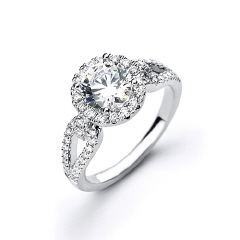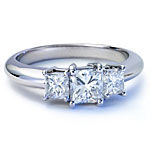
That’s right. I added a couple C’s to the GIA’s original four. But let’s start at the beginning…
An engagement ring may be the most important jewelry purchase anyone makes. Not only does It represent a lifetime commitment, it may be the only piece of jewelry a woman never removes. Like the marriage itself, it should be beautiful, timeless and able to withstand many decades – and a few hard knocks.
Diamonds are (hopefully) forever
The diamond represents 80 to 90 percent of the cost of an engagement ring. It’s by far the most important part of the purchase.
Unless the bride or the groom happens to be a gemologist, the idea of buying a diamond is probably a little intimidating. Take time to shop around and educate yourselves. A good place to start is with the four C’s: cut, clarity, color and carat weight. An even better place is with that other C: cost.
Cost
Let’s start with the fifth C because – well, it’s been a rough year and we all need to be extra careful to get the most for our hard-earned dollars.
A couple should decide how much they want to spend before they begin shopping. One guideline suggested by De Beers’ Diamond Information Center is to budget the equivalent of two months’ salary — a good starting point, but by no means mandatory.
When you’re budgeting, don’t go crazy. You have a lifetime to buy bigger diamonds. Decide what you’re comfortable spending and don’t let anyone pressure you into buying more. No matter what you’re spending, go for quality. The quality diamond is the most beautiful.

Carats
Weight (in carats) determines size in diamonds. You’ll want the most beautiful stone you can afford, and that may mean settling for smaller size in order to maximize quality. Most of us have an idea of what a half-carat diamond looks like by now. Just remember, those multi-carat sparklers you see on the Red Carpet wouldn’t sparkle without the other C’s.
Preferences for carat weight vary from region to region. In Southwest resorts, for example, bigger is often better, but in San Franciso and Boston, the preference is usually for quality over quantity—a small, flawless diamond instead of a carat-heavy one that wouldn’t pass GIA standards.
Clarity
Most diamonds contain minute flaws called inclusions. Under a magnifying loupe, these look like tiny clouds. Truly flawless diamonds are very rare. You’ll find inclusions rated by code: FL for flawless, VS for very slightly included, SI for slightly included and I for imperfect. Each category is numbered, 1 being the least included in each category.
Color
Unlike other gemstones, it’s lack of color that marks a fine diamond. Traces of yellow, brown or gray decrease the value. Every diamond is color-graded with an alphabetical code, a D grade being the highest and S to Z noticeably yellow.
Cut

Most experts agree that cut is the most important element. A poor cut can virtually destroy even a flawless diamond. You will have several standard shapes to choose from: round, emerald, marquee, oval, pear or heart shapes. But when people refer to “cut,” they’re usually talking about faceting, the angles cut in a stone to reflect light.
A good cut maximizes the sparkle, fire and brilliance of a stone. Light rays enter through the “table,” the surface of the “crown” or top part of the stone, then reflect off the facets cut into the “pavilion” at the bottom. A good cut reflects the rays back to the eye, causing that sparkle we love.
Certification (the sixth C)
If you’re buying a high-quality diamond, another C you should consider is certification. There are various certificates available from various laboratories, but the most stringent is from the Gemological Institute of America (GIA). If an expensive stone doesn’t have a certificate something is not being disclosed.
Lazare Kaplan diamonds come numbered with a microscopic logo laser- inscribed into the girdle. For a cost of about $25, a GIA mark can be similarly branded, for added insurance.
Next week: a few tips about the ring itself: the perfect mount, the perfect design for you – and few options you might not have considered

